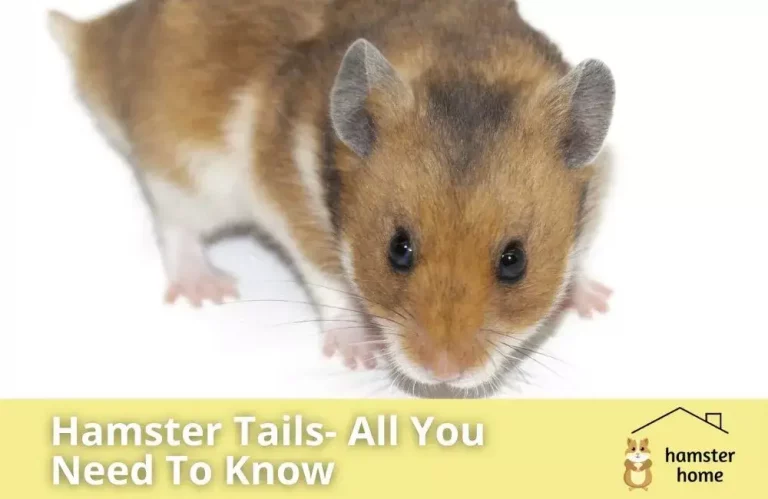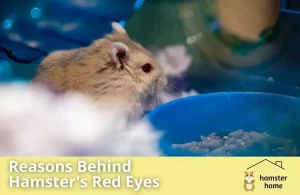So, do hamsters really have tails? Yes, hamsters have tails, but sometimes they are too small that you barely notice them. Hamsters have small tails for so many reasons. First of all, it helps them quickly escape any deadly encounter with predators. Moreover, these tiny tails also give them some extra stability while running through different terrains.
There are a lot of interesting facts related to the tails of the hamsters. On top of that, you should be well aware of your hamster’s body to take care of it properly. Hence, stay tuned till the end of this thread.
Hamsters’ Tail Length According To Their Breed
If you think that all the hamster breeds have the same type of tails, you won’t after reading this post. Hamster breeds are different from each other in many aspects, including their tails too.
Some hamster breeds have little tails that are barely noticeable compared to others that have long tails.
You might be reading about hamster’s tails to get one as a pet, so let’s move on to the tail length size of the most famous pet hamster breeds:
Syrian Hamsters
If you’re looking to get a big hamster, you can choose Syrian hamsters. They are the biggest hamster breed and can grow several inches in length. However, the tail size of Syrian hamsters will amaze you for being a contradiction to their big size.
The average size of a Syrian hamster’s tail isn’t more than half an inch. The tail size is almost six times less than the total body size of the Syrian hamster. If you get a hairy Syrian hamster, then you’ll face a hard time identifying its tail because it will be all covered in hairs.
Russian Dwarf Hamsters
Also known as Campbells, this breed is smaller than Syrian hamsters. With a body size of 3 to 4 inches, their tail size is similar to Syrian hamsters. Campbell’s tails are easy to find due to their big size and light fur.
Roborovski Dwarf Hamsters
They are known as the smallest hamster breed and do not grow more than 2 inches in size. Tails of Roborovski Dwarf Hamster are even shorter, about 1/8 of an inch. Being a fast-running breed, you’ll face a hard time spotting their little tails.
Winter White Hamsters
Like Russian dwarf hamsters, the Winter White hamster is another dwarf breed. The tail size, coloration, and structure of these breeds are similar.
Chinese Hamsters
Due to the Chinese hamster’s tail, this breed is often compared with mouse or gerbil. The tail can grow as big as the body of the Chinese hamster. The tail length of the Chinese hamster is a unique feature that makes it different from other hamster breeds.
Why Do Hamsters Have Short Tails?
As hamsters closely resemble mice and rats, so you might think about the difference in the tail length. Most hamsters have short tails, and the reason for this is not very clear yet. One of the reasons that can justify their short tails is evolution.
It’s possible that hamsters would have long tails in the past. But over time, the tail size might have been reduced as they don’t need it often. Rats and mice are awful climbers, and their tails provide them stability during climbing.
Unlike rats and mice, hamsters don’t like climbing. Instead, they keep themselves busy by digging burrows. For this, they don’t need stability to hold themselves firmly on the ground. So, this might be the reason for the short hamster tails.
How Hamsters Use Their Tails?
Any animal that has a tail uses it for a purpose. For example, rats use their tails to balance themselves, while dogs whip or wag them when they are happy or sad. So, their tails are used for communication or doing some work.
Hamsters’ tails are very small, and there are no clear answers that why they even exist. The purpose of the hamsters’ tails might be similar or different. But, if the purpose is the same, you might think about why the size is different.
Here are the most popular beliefs related to the use of the hamsters’ tails:
- Like rabbits, hamsters love digging borrows and live underground. They don’t need long tails for climbing as their little paws are enough to dig the Earth and soil. But their small tails make the task easy as they don’t get in their way while digging the ground. A long-tail would have increased the risk of getting hurt or stuck somewhere in the way.
- Although hamsters prefer to live an easy life, sometimes they give themselves a hard time by digging a difficult terrain. While digging a rough patch of land, they need more stability, and their short tails are good at keeping them stable.
- A hamster’s tail is located in front of the bottom area. Most hamster owners believe that the purpose of the hamster’s tail is to protect this sensitive area. Especially during burrowing, hamsters need protection that is provided by their tails.
- Like dogs and other animals, hamsters also use their tails for communication. If a female hamster is near a male hamster, she will raise its tail to show interest in mating.
How To Take Care Of Hamster Tails?
Just like cats and dogs, hamsters can also harm their little tails. You have to be careful regarding this to ensure that your hamster doesn’t get into trouble that can damage its tail.
The most common thing that can damage your hamster’s tail is its playtime in the exercise ball. When the ball twists, your hamster will surely enjoy it, but the risk of damaging the tail increases. So, whenever your hamster is in the exercise ball, keep an eye on it. If anything happens, help your hamster immediately to protect its tail.
Besides these accidents during playtime, a common hamster illness, known as wet tail, can also attack your hamster’s tail. It’s a deadly disease and is often hard to diagnose in the early stages.
But, if you’re careful enough, you can spot this bacterial infection from the following signs:
- Diarrhea
- Lethargy
- Loss of appetite
- Sunken eyes
- No energy for grooming
- Bended posture
If not diagnosed and treated on time, this disease will not only damage your hamster’s tail but can be fatal for your little furry buddy.
FAQs
No, hamsters can’t regrow their tails. Hamsters’ tails grow with their body till they are fully matured. After that, their tails stop growing. So, if any damage occurs to your hamster’s tail, your hamster has to lose its tail forever. So, in case your hamster’s tail gets hurt, take it to a vet right away to treat the problem and protect its tail.
No, hamsters’ tail doesn’t fall off as a defense mechanism in the presence of predators. It’s a common myth that hamsters can lose their tail like lizards when in danger. However, the truth is that they don’t lose their tails in danger. Instead, tail loss occurs only if the hamster is injured.
Yes, hamsters’ tails tell about the overall health of hamsters. A clean and healthy-looking tail indicates a good health status of hamsters. In contrast, if the tail is looking bad or smelly, then your hamster might be suffering from a health condition.
Hamster’s Tails Rolled Up
Here we end our guide on hamsters’ tails covering everything regarding the tail length of various hamster breeds, use, and care. Now, you understand that although hamsters’ tails are short, they need care like your hamsters’ other body parts. So, take some time and understand your hamster’s breed a bit more to find the best ways to protect its small tail.







